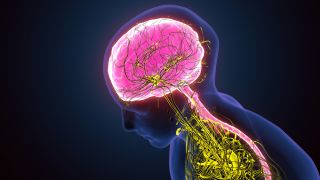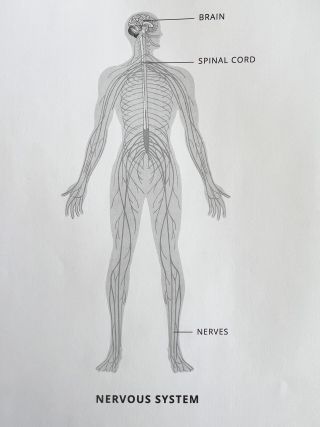Stress
How a Confused Nervous System and Stress Create Pain
There are stress-related disorders not directly linked to stress.
Posted November 7, 2023 Reviewed by Ray Parker
Key points
- Chronic headaches, back pain, and irritable bowel are types of central sensitization syndromes (CSS).
- CSS is caused by nerve sensitization, which makes the nervous system more sensitive to pain stimuli.
- People with CSS often feel misunderstood and dismissed by their healthcare providers.

Chronic migraines, back pain, and irritable bowel syndrome are types of central sensitization syndromes (CSS). CSS affects upwards of 30 million adults in the United States.
They are a common reason for chronic pain and why people seek out opioids. Yet, in my experience, a central driver of these disorders, unrelenting stress, is rarely addressed in mainstream medical clinics. To bridge this gap in the healthcare system, I will talk about them here.
Role of Stress on Performance
First, let's review the role of stress on performance. I promise to be brief.

The Yerkes-Dodson curve shows the relationship between stress and performance. Mild or even moderate levels of stress enhance performance. It's a good stress—yes, there is such a thing. That's when you are motivated and focused.
When stress level keeps escalating, you hit unmanageable levels that lead to overload and burnout, what I call the red zone.
Here is where you reach exhaustion, anxiety, anger, or a combination of these stress-related states.
When you are living in the red zone, the body's weakest link is bound to break.
Stress Breaks the Weak Links
During my clinical practice, I observed that people living in the red zone developed one or more of a variety of stress-related disorders (SRD):
- Disabling headaches
- Miserable back pain
- Embarrassing digestive issues
- Crippling bladder pain
I decided to look deeper at the underlying cause of these disorders. What was the common thread that connected them?

Between my research and observations, I found long-term, overwhelming stress provokes dysfunction in the nervous system. The disorders share a type of problem in the nervous system called nerve sensitization.
Sensitization arises from abnormalities in how pain signals are processed and perceived in the brain and nerves. It makes the nerves more sensitive and reactive to stimuli, which increases pain levels.
I witnessed numerous people develop one or more of these disorders while under high stress. Their bodies snapped and broke under unmanageable demands, like a bridge carrying too much weight for too long. At first, cracks develop. If the weight continues, the structure buckles under the pressure.
Headaches, back pain, and digestive issues are sensitive to stress levels. Living daily under high stress or in the stress response breaks the body down. Your body wasn't designed to live each day wrangling with the checkbook for survival.
The stress response was designed to help you evade becoming a bear's lunch, a brief burst of high-octane fuel and adrenaline to improve survival.
Over time, the stress response overloads your nervous system until it breaks like an overloaded, blown fuse. The overload results in exploding migraines, flaring back pain, or the ongoing cramping of irritable bowel. You may feel the symptoms in your head, back, or gastrointestinal tract, but the problem may reside in the nervous system from sensitization.
The Pattern
As a physical medicine and rehabilitation doctor, my clinic was a funnel for sensitization syndromes. Once the traditional medications or procedures failed to help, people were referred to me for symptom management. These people shared the same pattern:
- They had disabling symptoms with medical tests that were primarily normal.
- They were desperate for help and felt their providers thought their symptoms were all in their heads.
- They had seen multiple providers with no answers and had undergone numerous procedures that did not help or worsen their symptoms.
A frequent referral was for people with chronic severe back pain without a clear explanation for the intensity of their symptoms. These people had severe pain, even though their tests showed only mild abnormalities.
For example, they had mild arthritis in their lower back, but they were unable to work due to the pain level. Standard care—such as physical therapy, anti-inflammatory medications, and injections—had resulted in minimal benefit. Procedures or surgeries worsened symptoms. Their providers were puzzled at best and dismissive at worst.
These patients feared a severe medical issue had been overlooked or that they imagined their distress. They were suffering, but when tests showed no reason for their misery, they questioned themselves. "Is it possible what I'm feeling isn't real?" How could something hurt so much and nothing be wrong?
Debilitating symptoms with standard medical tests is a hallmark sign of sensitization. A confused nervous system exaggerates pain signals because it believes the body is in danger.
Stress levels amplify the pain level even higher. I expand on this further and discuss treatment in my book, Sunbreak: Healing the Pain No One Can Explain.
References
Muhammad B. Yunus, “Editorial Review (Thematic Issue: An Update on Central Sensitivity Syndromes and the Issues of Nosology and Psychobiology),” Current Rheumatology Reviews 11, no. 2 (July 2015): 70–85. https://doi.org/10.2174/157339711102150702112236.
Mary-Ann Fitzcharles et al., “Nociplastic Pain: Towards an Understanding of Prevalent Pain Conditions,” The Lancet 397, no. 10289 (May 2021): 2098–2110.




